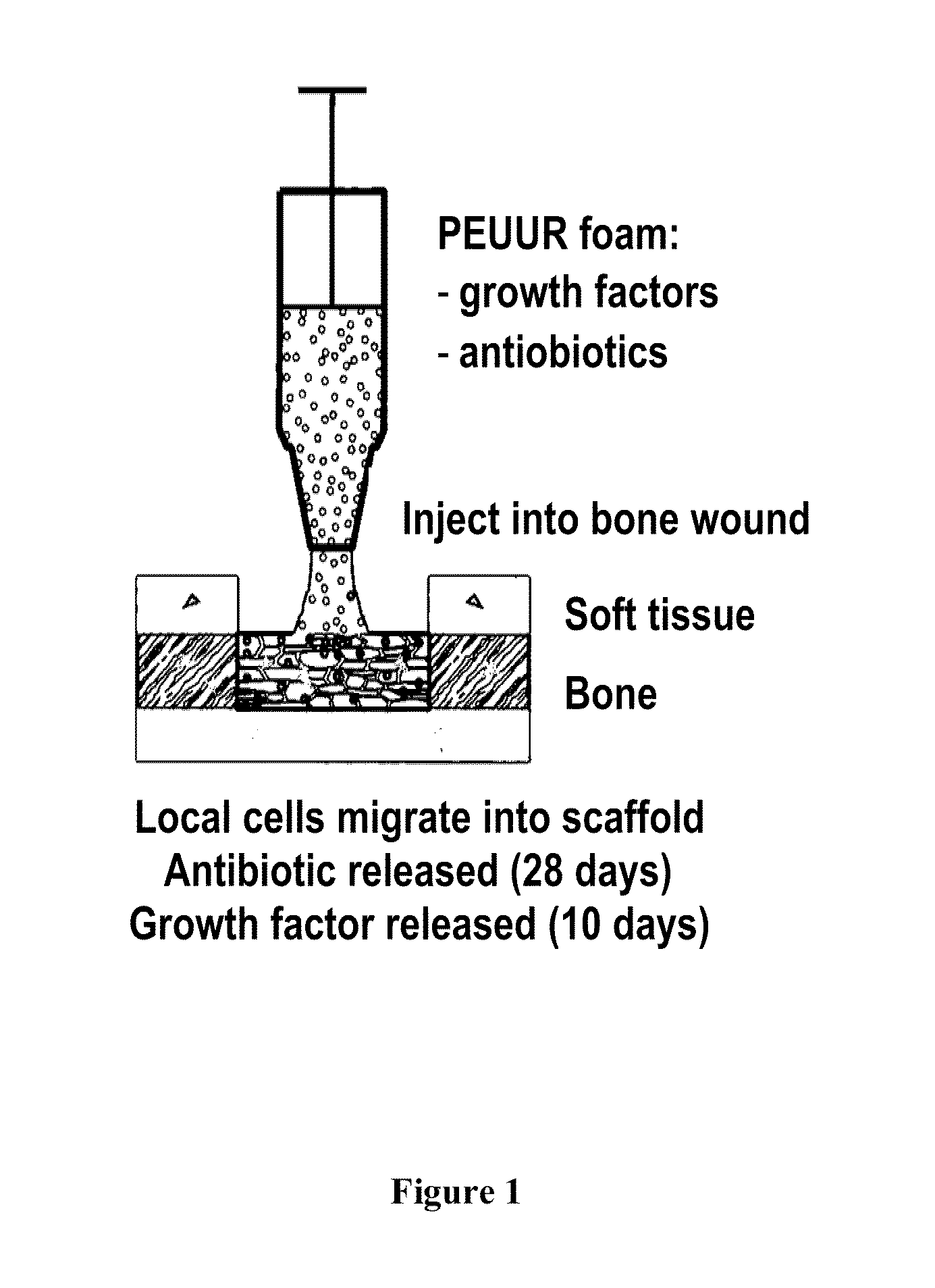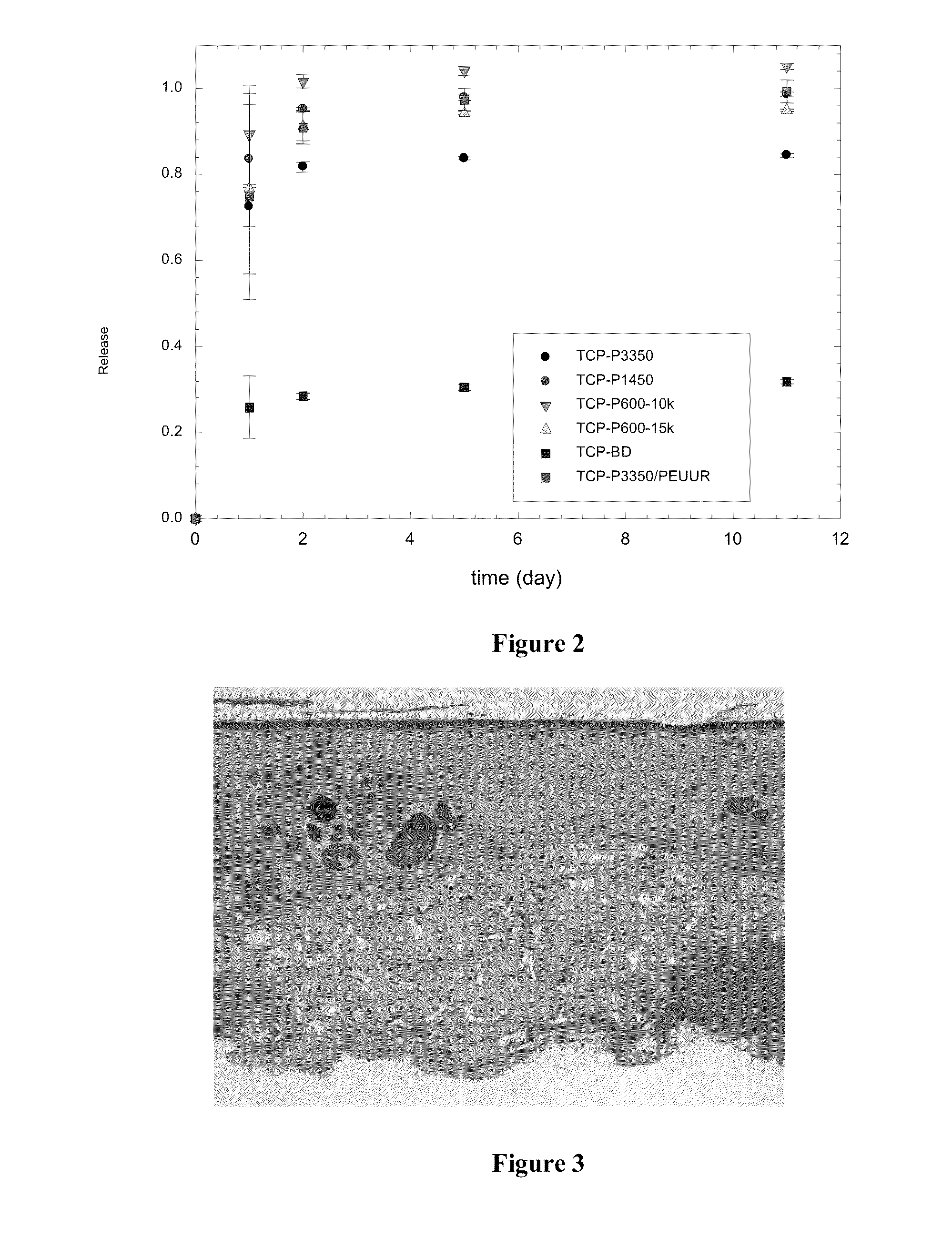Injectable dual delivery allograph bone/polymer composite for treatment of open fractures
a polymer composite and allograph technology, applied in the direction of prosthesis, drug composition, peptide, etc., can solve the problems of infection, compromising fracture healing, complicated healing, etc., to promote bone healing, reduce infection, and facilitate healing
- Summary
- Abstract
- Description
- Claims
- Application Information
AI Technical Summary
Benefits of technology
Problems solved by technology
Method used
Image
Examples
example 1
[0100]This Example demonstrates an aspect of the present invention, and more specifically a method of making a PUR scaffold of the present invention.
[0101]Glycolide and D,L-lactide were obtained from Polysciences (Warrington, Pa.), tertiary amine catalyst (TEGOAMIN33) from Goldschmidt (Hopewell, Va.), polyethylene glycol (PEG, MW 600 Da) from Alfa Aesar (Ward Hill, Mass.), and glucose from Acros Organics (Morris Plains, N.J.). Lysine triisocyanate (LTI) from Kyowa Hakko USA (New York), and hexamethylene diisocyanate trimer (HDIt, Desmodur N3300A) from Bayer Material Science (Pittsburgh, Pa.). PDGF-BB was obtained from Amgen (Thousand Oaks, Calif.). Sodium iodide (Na125I) for radiolabeling was purchased from New England Nuclear (part of Perkin Elmer, Waltham, Mass.). Reagents for cell culture from HyClone (Logan, Utah). All other reagents were from Sigma-Aldrich (St. Louis, Mo.). Prior to use, glycerol and PEG were dried at 10 mm Hg for 3 hours at 80° C., and ε-caprolactone was dried...
example 2
[0108]This example describes how to make an example of the foam of the preset invention, and further describes tobramycin release.
[0109]A polyurethane foam of the present invention may be synthesized by two-component reactive liquid mixing of hexamethylene diisocyanate trimer (Desmodur N3300A) and hardener consisting of a poly(ε-caprolactone-co-glycolide-co-lactide) triol, poly(ethylene glycol) (PEG, MW 600), water, triethylenediamine catalyst, sulfated castor oil stabilizer, and calcium stearate pore opener using previously reported techniques. Lyophilized, powdered antibiotic (tobramycin or colistin) and glucose excipient were mixed thoroughly with the hardener component before foam synthesis, with a total solids maximum of 8 wt-%. Tobramycin-containing PLGA microparticles were likewise included at 25 wt-% in some of the foams.
[0110]In vitro release of tobramycin was measured from triplicate 20-mg foam samples each in 1 mL PBS at 37° C. 500 uL of the PBS was removed and refreshed ...
example 3
[0115]This example demonstrates an additional method of making a foam of the present invention, including the incorporation of tobramycin.
[0116]Glycolide and D,L-lactide were obtained from Polysciences (Warrington, Pa.), tertiary amine catalyst (TEGOAMIN33) from Goldschmidt (Hopewell, Va.), polyethylene glycol (PEG, MW 600 Da) from Alfa Aesar (Ward Hill, Mass.), and glucose from Acros Organics (Morris Plains, N.J.). Tobramycin was obtained from X-Gen Pharmaceuticals (Big Flats, N.Y.), and hexamethylene diisocyanate trimer (Desmodur N3300A) was obtained from Bayer Material Science (Pittsburgh, Pa.). All other reagents were purchased from Sigma-Aldrich (St. Louis, Mo.). Prior to use, glycerol and PEG were dried at 10 mm Hg for 3 hours at 80° C., and e-caprolactone was dried over anhydrous magnesium sulfate, while all other materials were used as received. Simplex P cement beads with Tobramycin were obtained from Stryker (Mahwah, N.J.).
[0117]Polyurethane (PUR) scaffold synthesis. The 9...
PUM
| Property | Measurement | Unit |
|---|---|---|
| porosity | aaaaa | aaaaa |
| density | aaaaa | aaaaa |
| density | aaaaa | aaaaa |
Abstract
Description
Claims
Application Information
 Login to View More
Login to View More - R&D
- Intellectual Property
- Life Sciences
- Materials
- Tech Scout
- Unparalleled Data Quality
- Higher Quality Content
- 60% Fewer Hallucinations
Browse by: Latest US Patents, China's latest patents, Technical Efficacy Thesaurus, Application Domain, Technology Topic, Popular Technical Reports.
© 2025 PatSnap. All rights reserved.Legal|Privacy policy|Modern Slavery Act Transparency Statement|Sitemap|About US| Contact US: help@patsnap.com



